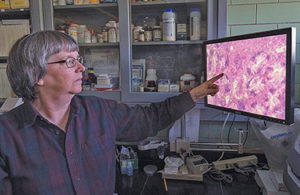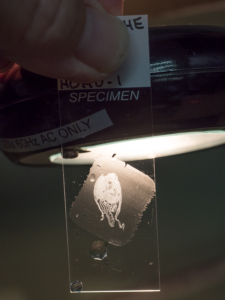For nearly seven decades, wild oyster (Crassostrea virginica) populations in the Chesapeake Bay have languished at the mercy of two marine parasites. The rugged looking oyster proved to be not so hardy when infected by either Haplosporidium nelsoni, responsible for MSX, or Perkinsus marinus (aka Dermo for its original classification as Dermocystidium marinum). Both are single-celled parasites that infect oysters and when infection rates are high enough, they can kill their hosts.
Scientists at the Virginia Institute of Marine Science (VIMS) and at the Maryland Department of Natural Resources have spent those decades examining oysters to learn more about these destructive parasites. Researchers at the Cooperative Oxford Lab (Oxford Lab), a federal-state lab on Maryland’s Eastern Shore and its counterpart at the Virginia Institute of Marine Science (VIMS) collect hundreds of oysters every year for inspection. They take tissue samples and look at stained, very thin cross-sections under a microscope. These examinations of the oyster’s intestinal tract can show scientists where the parasites are located in the oyster tissues.

DNR pathologist Carol McCollough points to indication of disease in magnified slide of oyster tissue. (Dave Harp for The Bay Journal)
Researchers are noticing some encouraging trends in the parasites over time. MSX infections have dramatically receded in the Bay, now only found in around 11% of oysters in Maryland. Dermo, however, is widespread, infecting nearly two-thirds of Maryland oysters, but it is not as lethal as it has been in the past.
“The trend that we’re really seeing is that the mortality consequences of those disease pressures seem to be fairly consistently less than they were in previous years,” said Chris Dungan, a DNR research scientist who oversees the Oxford lab’s oyster evaluations. Although there’s no direct evidence, Dungan said he and others think that the decline in dead oysters found in surveys “reflects increasing resistance to those diseases… by the process of natural selection.”
Ryan Carnegie, Dungan’s counterpart at VIMS, said that although it’s largely circumstantial, he also sees evidence that oysters have developed resistance to becoming infected by MSX. And there are indications, he added, that they’ve developed an ability to tolerate Dermo without succumbing to it.

A super-thin cross section of oyster is mounted on a slide for examination. (Dave Harp for The Bay Journal)
“The baseline for Dermo levels in the Bay has increased,” Carnegie said, “yet the oysters are doing better and better…They’re not allowing themselves to be completely overrun by the parasite.”
That’s a big deal, he added, because at its peak, MSX was killing 90 percent of the oysters it infected in the Bay, and Dermo was killing 70 percent of those it infected — every year.
One of Carnegie’s graduate students, Lauren Huey, is looking into another phenomenon that may be a byproduct of oysters’ growing ability to tolerate Dermo — though infected, they are ramping up their ability to reproduce.
Since 2003, around the time of the last major Dermo outbreak in the Bay, Carnegie said that research shows infected oysters have been able to increase their egg production. “We don’t fully understand how they’re doing it,” he said, but it’s clear that oysters are living longer in the Bay than they used to. As a result of that longevity, they’re reaching bigger sizes and producing more eggs.
Carnegie cautioned that the Bay’s oysters aren’t going to be free of the specter of disease anytime soon. “It’s still a dominant factor influencing oysters,” he said, “but the oysters are starting to regain control of the situation and they’re doing much better.
“This has taken decades, and it’s a long race,” he concluded. The key to continued progress may lie, he suggested, in protecting the continued survival of those oysters that apparently have the right genes to fend off or live with the diseases.
For Bay scientists and managers, Carnegie said, “It’s a matter of promoting policies that are going to help the oyster help itself as it fights these parasites.”
To some, that may sound like leaving a significant number of bigger, older oysters unharvested so they can produce offspring — the intent behind establishing sanctuaries.
Original article published in the Bay Journal.
